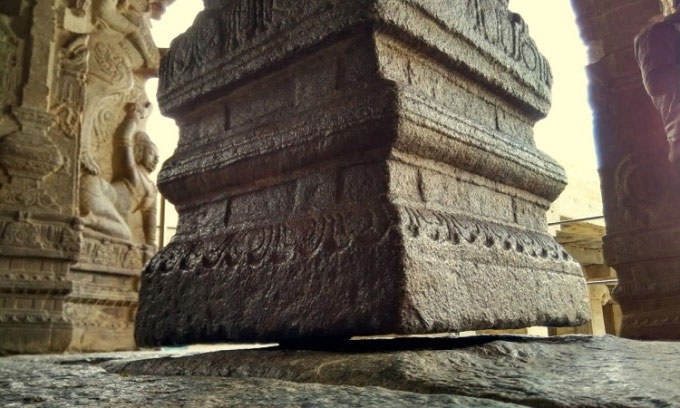Gravity Defying Pillar in Indian Temple
The nearly 5m high pillar hangs from the temple ceiling and does not touch the ground, giving researchers a headache about the ancients' construction methods and intentions.
In the heart of Lepakshi village, Andhra Pradesh, lies a wonder of ancient Indian architecture : a temple with a pillar that does not touch the ground at all. This curious phenomenon has made the temple the focus of research, raising questions about the method and intention of the pillar's construction, according to Ancient Origins .

The suspended pillar at the Veerbhadra temple. (Photo: Wikipedia).
The Veerbhadra Temple in Lepakshi village is famous for its 16th-century mosaics and sculptures. However, the most famous is the floating pillar that seems to defy the laws of gravity. The stone pillar is about 4.6m high and decorated with intricate carvings that seem to hang from the ceiling with the base barely touching the ground, allowing a piece of cloth or towel to fit through the gap.
According to the interlocking theory, the pillar may have been composed of perfectly balanced blocks of stone, creating the illusion of a floating object. However, researchers have not found any joints to prove this. Others have speculated that the pillar may have been partially hollow, reducing its weight and giving it the appearance of floating. Additionally, given the seismic activity in the area, many scholars have suggested that the unique design of the pillar may have been intentional by the temple's builders to make the structure more earthquake-resistant.
During the colonial period, a British engineer tried to uncover the mystery behind the hanging pillar at the Lepakshi Temple . He managed to move the pillar, causing it to shift out of place. This accident caused part of the temple's roof to collapse, but also made the pillar even more mysterious, attracting more people to visit and study it.
The historical importance of the Lepakshi Temple lies in its association with the Vijayanagara Empire, one of the most prominent and influential empires in the history of South India. The empire was ruled by the Sangama and Saluva dynasties and flourished during the 14th to 17th centuries. The construction of the Lepakshi Temple during this period is a testament to the artistic, cultural and religious achievements of the empire.
- Vacuum pillar touches strange land in Indian temple
- Huge gravity hole under the Indian Ocean
- Egypt salvaged the pillar of Isis temple
- Mysterious iron pillar of 1,600 years old stainless steel
- Gravity, gravity and things we still think
- Taj Mahal - Pearl of the Indian temple
- Treasures of $ 22 billion in ancient Indian temples
- Mystery of temples 'timeless' in India: There is a value of up to 100 billion USD!
- Excavating the 5,000-year-old temple ruins
- The first time we can see gravity
- Russia built anti-gravity engines
- What happens when gravity on Earth halves?
 The truth about the mysterious red-haired giant at Lovelock Cave
The truth about the mysterious red-haired giant at Lovelock Cave Inunaki Tunnel: The haunted road leading into Japan's 'village of death'
Inunaki Tunnel: The haunted road leading into Japan's 'village of death' The mystery of the phenomenon of human reflection before dying
The mystery of the phenomenon of human reflection before dying 6 mysterious phenomena, although science has been developed for a long time, still cannot be answered
6 mysterious phenomena, although science has been developed for a long time, still cannot be answered